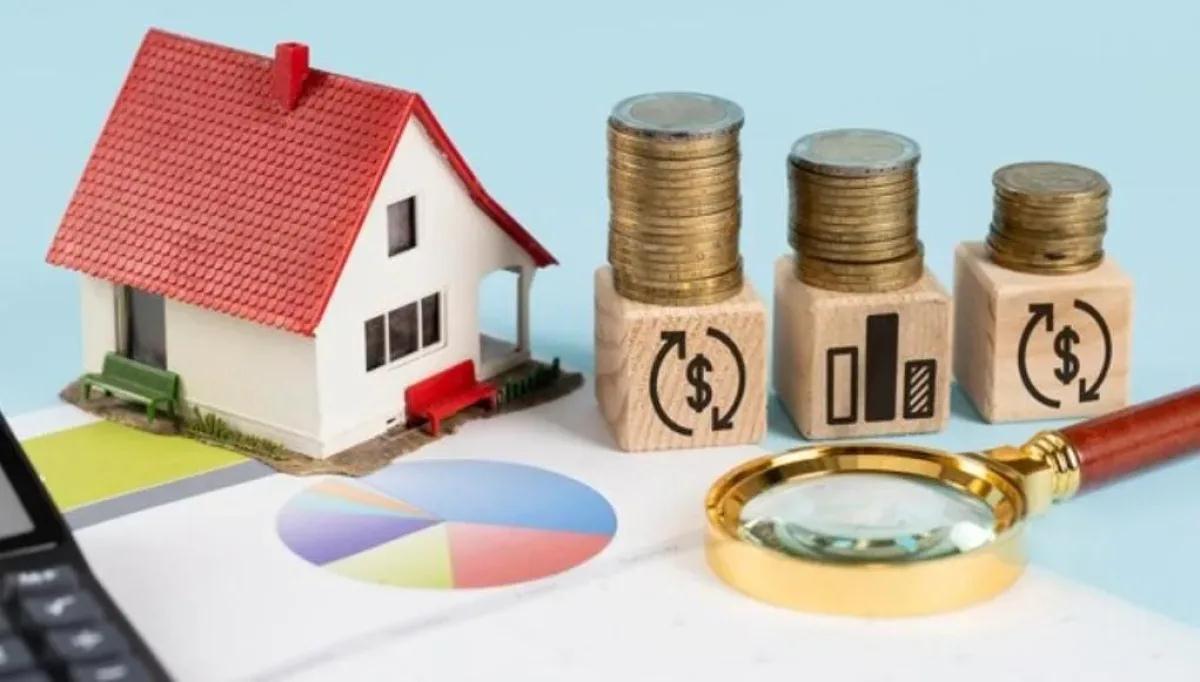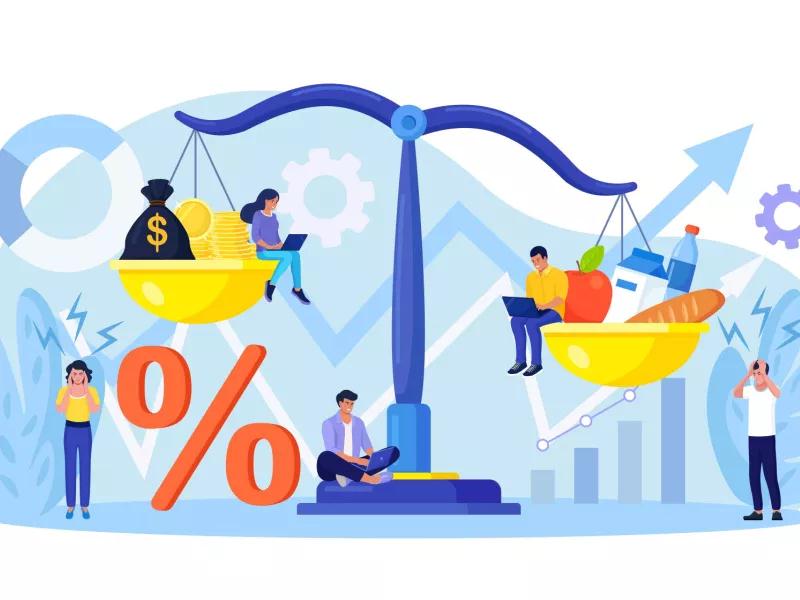Believed to have originated in 17th century Italy, compound interest can be thought of as “interest on interest” and will cause the sum to grow at a faster rate than simple interest, which is calculated only on the principal amount. .
The rate at which compound interest accrues depends on the frequency of compounding, so the greater the number of compounding periods, the greater the compound interest. Therefore, the amount of compound interest accrued on $100 compounded at 10% annually will be less than that on $100 compounded at 5% semi-annually over the same time period. Since the interest-on-interest effect can generate increasingly positive returns based on the initial principal amount, it is sometimes known as the “miracle of compound interest.”
Calculation of compound interest
Compound interest is calculated by multiplying the initial principal amount by one plus the annual interest rate raised to the number of compound periods minus one. The total initial loan amount is subtracted from the resulting value.
The formula to calculate compound interest is:
Compound interest = Total amount of principal and interest in the future (or future value) minus the principal amount in the present (or present value)
= [P (1 + i) n] – P
= P [(1 + i) n – 1]
(Where P = Principal, i = nominal annual interest rate in percentage terms, and n = number of compounding periods.)
Let’s take a three-year loan of USD 10,000 at an interest rate of 5% that accrues annually. What would be the amount of interest? In this case, it would be: USD 10,000 [(1 + 0.05) 3 – 1] = USD 10,000 [1.157625 – 1] = USD 1,576.25.
Compound Interest Growth
Using the example above, since compound interest also takes into account interest accrued in prior periods, the interest amount is not the same for all three years, as it would be with simple interest . While the total interest payable over the three-year period of this loan is $1,576.25, the interest payable at the end of each year is shown in the table below.
Composite periods
When calculating compound interest, the number of compounding periods makes a significant difference. The basic rule is that the greater the number of compounding periods, the greater the amount of compound interest.
The following table demonstrates the difference that the number of compounding periods can make on a $10,000 loan with a 10% annual interest rate over a 10-year period.
Compound interest can significantly increase investment returns over the long term. While a $100,000 deposit receiving 5% simple interest would earn $50,000 in interest over 10 years, 5% compound interest on $10,000 would equal $62,889.46 over the same period.
Compound Interest Calculation in Excel
If it’s been a while since your last math class, fear not: there are useful tools to help calculate compound interest. Many calculators (both handheld and computer-based) have exponent functions that can be used for these purposes. If more complicated compound interest tasks arise, they can be done with Microsoft Excel, in three different ways.
The first way to calculate compound interest is to multiply each year’s new balance by the interest rate. Suppose you deposit $1,000 in a savings account with an interest rate of 5% that accrues annually, and you want to calculate the balance in five years. In Microsoft Excel, enter “Year” in cell A1 and “Balance Sheet” in cell B1. Enter years 0 through 5 in cells A2 through A7. The balance for year 0 is $1,000, so you enter “1000” in cell B2. Then, enter “=B2 * 1.05” in cell B3. Then enter “=B3 * 1.05” in cell B4 and continue doing this until you reach cell B7. In cell B7, the calculation is “=B6 * 1.05.” Finally, the value calculated in cell B7 USD 1,276.28 is the balance in your savings account after five years. To find the value of compound interest, subtract $1,000 from USD 1,276.28; This gives it a value of USD 276.28.
The second way to calculate compound interest is to use a fixed formula. The formula for compound interest is ((P * (1 + i) ^ n) – P) , where P is the principal, i is the annual interest rate, and n is the number of periods. Using the same information above, enter “Primary Value” in cell A1 and 1000 in cell B1. Next, enter “Interest Rate” in cell A2 and “.05” in cell B2. Enter “Compound Periods” in cell A3 and “5” in cell B3. You can now calculate compound interest in cell B4 by entering “=(B1 * (1 + B2)^B3)-B1”, which gives you $276.28.
Using other calculators
As mentioned above, several free compound interest calculators are offered online, and many portable calculators can perform these tasks as well.
The free compound interest calculator offered through Financial-Calculators.com is simple to operate and offers compound frequency options from daily to yearly. It includes an option to select continuous composition and also allows entry of the actual calendar start and end dates. After entering the necessary calculation data, the results show interest earned, future value, annual percentage yield (APY), which is a measure that includes compounding and daily interest.
Investor.gov, a website operated by the U.S. Securities and Exchange Commission (SEC), offers a free online compound interest calculator. The calculator is quite simple, but allows for the entry of additional monthly deposits to the principal, which is useful for calculating earnings where additional monthly savings are deposited.
A free online interest calculator with a few more features is available at TheCalculatorSite.com . This calculator allows calculations for different currencies, the ability to take into account monthly deposits or withdrawals, and the option to automatically calculate inflation-adjusted increases to monthly deposits or withdrawals.
The frequency of capitalization
Interest can be compounded at any given frequency schedule, from daily to yearly. There are standard compounding frequency schedules that generally apply to financial instruments.
The compounding schedule commonly used for a savings account in a bank is daily. For a CDT, typical compounding frequency schedules are daily, monthly, or semiannual; for money market accounts, it is often daily. For mortgage loans, home equity loans, personal business loans, or credit card accounts, the most commonly applied compounding schedule is monthly. There may also be variations in the time period in which accrued interest is actually credited to the existing balance. Interest on an account can be compounded daily but only credited monthly. It is only when interest is actually credited, or added to the existing balance, that you begin to earn additional interest on the account.
Some banks also offer something called continuous compound interest, which adds interest to the principal at every possible moment. For practical purposes, you don’t accrue much more than daily compound interest unless you want to put money in and take it out the same day.
More frequent interest capitalization is beneficial for the investor or creditor. For the lender, the opposite is true.
Consideration of the time value of money
Understanding the time value of money and the exponential growth created by compounding is essential for investors looking to optimize their income and wealth allocation.
The formula to obtain the future value (FV) and the present value (PV) is as follows:
FV = PV (1 + i) n y PV = FV / (1 + i) n
For example, the future value of $10,000 compounded at 5% annually for three years:
= $10,000 (1 + 0.05) 3
= $10,000 (1.157625)
= $11,576.25
The present value of $11,576.25 discounted at 5% for three years:
= $11,576.25 / (1 + 0.05) 3
= $11,576.25 / 1.157625
= $10,000
The reciprocal of 1.157625, which is equal to 0.8638376, is the discount factor in this case.
Pros and cons of capitalization
While the magic of compounding has led to the apocryphal story of Albert Einstein, calling him the eighth wonder of the world or man’s greatest invention, compounding can also work against consumers who have loans that have very high interest rates, such as credit card debt. A credit card balance of $2,000 with an interest rate of 20% compounded monthly would result in a total compounded interest of $4,388 over a year or about $365 per month.
On the positive side, the magic of compounding can be an advantage for your investments and can be a powerful factor in wealth creation. The exponential growth of compound interest is also important in mitigating factors that erode wealth, such as increases in the cost of living, inflation, and reduced purchasing power.
Mutual funds offer one of the easiest ways for investors to reap the benefits of compound interest. Choosing to reinvest dividends derived from the mutual fund results in purchasing more shares of the fund. More compound interest accumulates over time, and the cycle of buying more shares will continue to help the investment in the fund grow in value.
Consider an open-end mutual fund investment with an initial sum of $5,000 and an annual sum of $2,400. With a 30-year average annual return of 12%, the future value of the fund is $798,500. Compound interest is the difference between the cash contributed to the investment and the actual future value of the investment. In this case, by contributing $770,000, or a cumulative contribution of just $200 per month, for 30 years, the compound interest is $721,500 of the future balance. Of course, earnings from compound interest are taxable, unless the money is in a tax-sheltered account; It is typically taxed at the standard rate associated with the taxpayer’s tax bracket.
Compound Interest Investments
An investor who opts for a reinvestment plan within a brokerage account is essentially using the power of compounding in whatever they invest in. Investors may also experience compound interest with the purchase of a zero coupon bond. Traditional bond issues provide investors with periodic interest payments based on the original terms of the bond issue, and because these are paid to the investor in the form of a check, interest does not accrue. Zero-coupon bonds do not send interest checks to investors; Instead, this type of bond is purchased at a discount to its original value and grows over time. Issuers of zero-coupon bonds use the power of compounding to increase the value of the bond so that it reaches its full price at maturity.
Compounding can also work for you when making loan payments. Making half your mortgage payment twice a month, for example, instead of making the full payment once a month, will end up shortening your amortization period and saving you a substantial amount of interest.
Determining if interest is compound
America’s Truth in Lending Act (TILA) requires lenders to disclose the terms of the loan to prospective borrowers, including the total dollar amount of interest that will be paid over the life of the loan. loan and whether interest accrues in a simple or compound manner.
Another method is to compare a loan’s interest rate with its annual percentage rate (APR), which TILA also requires lenders to disclose. The APR converts your loan’s finance charges, which include all interest and fees, to a simple interest rate. A substantial difference between the interest rate and the annual percentage rate means one or both of two scenarios: your loan uses compound interest, or it includes high loan rates in addition to interest. Even when it comes to the same type of loan, the APR range can vary wildly between lenders depending on the financial institution’s fees and other costs.
You will notice that the interest rate you are charged also depends on your credit score. Loans offered to those with excellent credit ratings have significantly lower interest rates than those charged to those with poor credit ratings.











